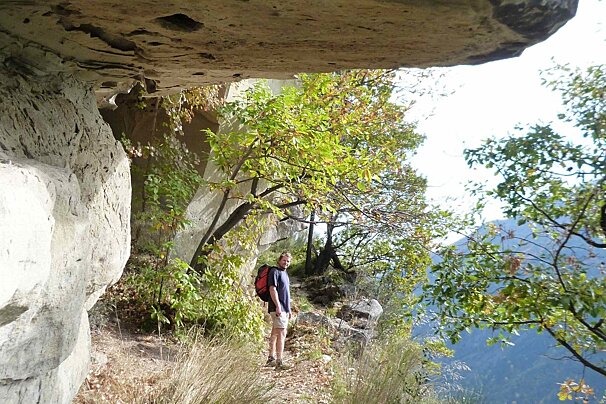
Gres d'Annot, Annot
35 million years ago the "Grès d'Annot" were born, a result of submarine avalanches composed of silt and sand.
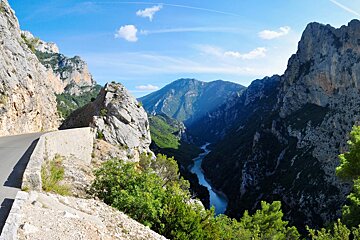
© SeeProvence.com

© Chateau Grand Boise

© SeeProvence.com/

© seeprovence.com/

© Seeprovence.com

© SeeProvence.com
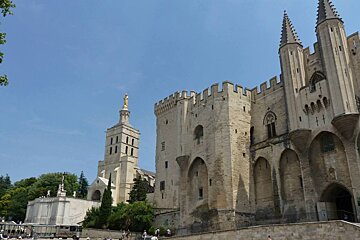
© P.Williamson
Discover the top Provence 'must see' sights and attractions
There are a wealth of places to visit in Provence, from top class art museums to the remains of ancient chapels and of course the famous vineyards. Many of the highlights are in Avignon, but to see the best that Provence has to offer, a car is recommended.
Thanks to the varied history of Provence, you will find reminders of the pre-historic times, Romans and of course the English throughout the region, from cave painting to castles and ruins to churches. Much of this history is documented in a number of museums.
But it is not just man-made artefacts that are worth seeking out. Provence is blessed with fabulous scenery, from the rows of vineyards, to the coast of the French Riviera, the mountains of Mont Ventoux and the fields of lavender. A number of Natural Parks have been created, which provide not only protection to the land but informative guides and trails to follow, a popular place for walking and biking.
Provence is home to a vibrant arts scene as evidenced by the number of excellent art galleries and museums found throughout. Historical art collections as well as contemporary can be seen across the region, and not forgetting of course those artists who were resident in the area such as Van Gogh, Cezanne, Matisse and Renoir.
Of course, one of the popular things for visitors to do whilst on holiday in Provence is to visit the many vineyards and chateaux. The collection includes some of the most famous and most expensive wines in the world.
Surprisingly, there aren't too many chateaus in Provence (when compared to the Loire for example). Of the ones that do exist and are open to the public, the impressive castles of Suze la Rousse, Grignan & Loumarin are certainly worth your time. The best chateau for our money is however, Chateau Les Baux - a mainly ruined castle that has been brought back to life to provide an authentic medieval experience for all the family.
Provence and the surrounding areas are home to some of the most famous cave paintings in France and indeed in Europe. A trip to the region would not be complete without experiencing some of the pre-historic remnants of the area, such as the Caverne du Pont d'Arc in the Ardeche or perhaps the Grottes de Villecroze.

35 million years ago the "Grès d'Annot" were born, a result of submarine avalanches composed of silt and sand.

You will be able to walk along the fossil bed of an ancient underground river, and discover the richness and diversity of this cave and eco-museum.

Finally visitors will be able to experience the cave paintings of the Grotte Chauvet in the state of the art replica that has been created by artists and builders.

This area is well known for it's ochre pigment found in the soil, and a tour of the Mines de Bruoux show you the underground caverns that were created.
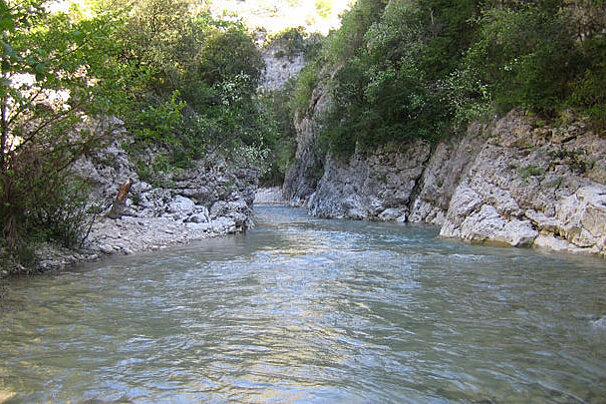
This river gorge runs for around 30 kilometres from the small village of Saint Leger, heading west along the borders of the Vaucluse and Drome regions.
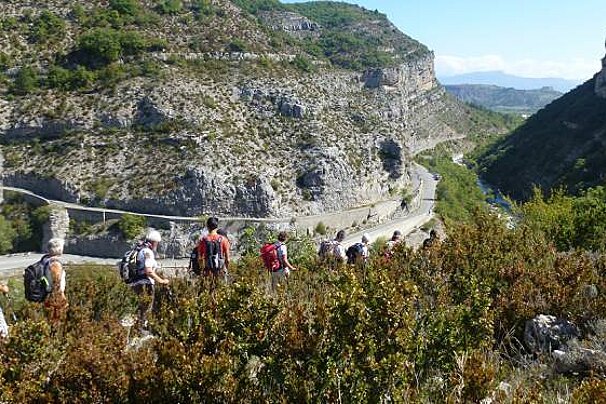
The Méaouge canyon is classed as a biological reserve thanks to its diverse flora and fauna, some of which come from as far away as north Africa and Iberia.
With it's rich history, Provence is blessed with some of the most ancient religious buildings in France. The Christians certainly knew how to create grand structures to proclaim their might and to cower any rivals. Some of the most impressive Catholic buildings include those in Avignon - the seat of the Popes in the 14th century, the Basillica in St Maximin la Sainte Baume, and the cathedral in Aix en Provence. Other notable buildings include the Russian Orthodox church in Nice, and the wonderful Cistercian abbeys in Thoronet & Senanque.
A number of superb country mansions owned in the past by the wealthy nobility have come to be open to the public, either due to the generous nature of the families involved, or because the houses have been bequeathed to the local council. Pretty much all of them contain authentic period furniture and furnishings, so you are able to step back in time and wonder at how the other half used to live. Many also have glorious gardens of different styles. Other inddependant gardens open to the public include Le Jardin de l'Alchimiste Domaine du Rayol in Le Rayol-Canadel.
Provence is indelibly linked to art and artists with a host of world famous artists having spent time in the region. From Cezanne to Picasso, Matisse to Renoir, art has played a huge part in the shaping of Provence today. So it is of no surprise to find that there are exceptional art galleries throughout Provence, showcasing landscapes & sculptures, modern and contemporary art.
Some have an entry fee, others (notably in Nice) are free. Depending on your tastes, you may want to visit the workshops or homes of Cezanne, Renoir or Van Gogh, or try one of the biggest collections of contemporary art at the Foundation Maeght or the abstract work of Foundation Vasarely.
The cultural heritage of Provence is displayed in museums throughout the region, but mainly within the larger centres such as Aix, Avignon & Nice. Collections of archaeological discoveries, specific historical time periods and agricultural & craftsmanship of Provence.
Much of the countryside in Provence is protected from development by being designated 'Reserves Naturelles' - both at a regional and a national level. The most famous natural park is that at Verdon, which boasts an enormous canyon that opens out on to a blue-green lake. It's a meca for outdoor & sports enthusiasts. The Carmargue is another well known natural park, famous for it's wetlands, bulls & white horses. The mountains of St Victoire and Ventoux also lie within protected areas.
Provence contains some of the most impressive Roman ruins that the Mediterranean has to offer. During their stay from the second century BC, they built aqueducts, temples, theatres and bridges. You must not miss the incredible Pont Du Gard near Nimes, or the Trophee d'Auguste in la Turbie. Arles, Nimes & Orange are stuffed full of Roman artifacts, as in the port town of Frejus. Perhaps the most atmospheric ruins are those of Glanum (near St Remy), which also boasts two almost perfect monuments - the Mausoleum of the Julii & the Triumphal Arch of Glanum.
Along with the usual high-street brands, designer labels and independent retailers, Provence is probably better known for it's daily farmers markets, antiques fairs and brocantes. IF you have money to spend then there is no doubt that Provence will help you spend it - whether it be on food, local specialities, fabric, hand made goods, crafts or wine...
Cycling, hiking or evening touring Provence by car, there is no better way to discover and enjoy this area than to move around it and experience the wide variety of landscapes, cultures and history that is on offer.
The area has produced wine for millennia (experts say for 2,300 years), thanks to the arrival of the Phoenicians and their vines. The appellation covers the region from the west of Marseilles to St Raphael in the east, through the area known as The Var. Whilst Cotes de Provence wines are mostly famous for their rose wines, rich, full-bodied reds are also produced, along with light and fresh white wines.

Arles is a veritable smorgasbord of culture, tradition, activity and adventure; and a little more of the romantic mystery of Provence is revealed when discovering the true vitality of this small city.

It may not be a big surprise to some to hear that the Avignon, the jewel in Provence's crown, is one of the most popular places in the world to be photographed.

After a busy visit to Arles, you would do well to leave the city for the expanse of the Alpilles, an impressive limestone range to the north-east. With an eerie luminosity the mountain chain is at once inviting and distant. But there's also familiarity: the barren, almost white rocks remind you of the Roman theatre and the Arena you left behind in Arles. And the crowds near and in Les Baux-de-Provence will rival and surpass those you encountered in the city.
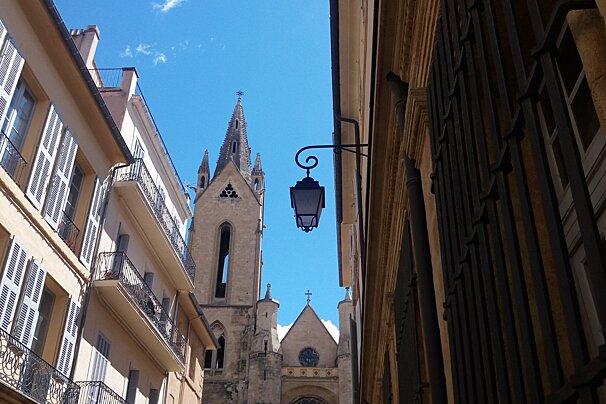
Beginning at the statue of the artist beside Fontaine de la Rotonde; arguably the grandest fountain in Aix, follow the “C” shaped medallions on the ground for a walking tour with a purpose.
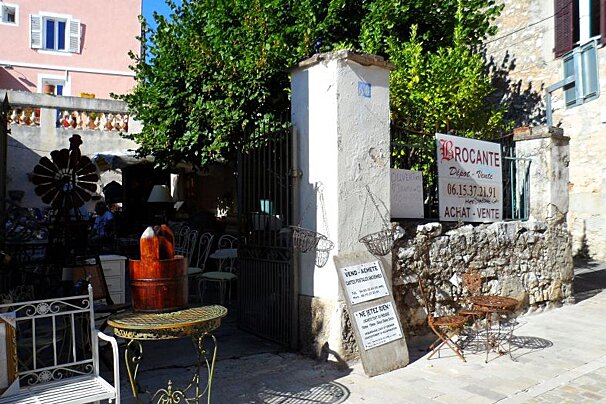
Provencal style is admired throughout the world and many visitors to this region come seeking one-of-a-kind items to take home with them. From antique furniture to salvage items, curios and vintage decorations, there is something for everyone whatever your budget. Try bargaining on the price, if you manage to get 10-20% off your purchase, you have done well!

If you've only got 24 hours, and lets face it, sometimes this happens when you're travelling, then we've prepared a jam packed schedule so that you can make the most of a flying visit to this inspiring city in Provence.

I decided to pay a visit to the amphitheatre during my stay in Arles and it turned out to be a pretty phenomenal experience.

In 1994 a limestone cave in the Ardeche was discovered that excited the archaeology world. Three caving enthusiasts discovered a cave richly decorated with charcoal drawings, hand prints and engravings that had been closed off by a rock fall for around 20,000 years keeping its contents in incredible condition. Named after one of the cavers, Chauvet Cave quickly became regarded as one of the greatest archaeological finds of our time.

Fort Saint André is more than just your average medieval fortress. As you walk through the two towers at the main entrance, it might seem like you're about to experience the typical cobblestone alleys and towering rock walls.

The Musée Réattu emanates an air of secrecy, long forgotten tales and unsettled uprising within its courtyards and high ceilinged rooms.

Looking for a little Roman history during you stay in Provence? Look no further than the city of Orange, located 20km north of Avignon.

The Van Gogh foundation is situated in a quiet side-street of Arles and has a fresh, modern aesthetic and fits beautifully within the narrow cobblestone streets.
Find out all about what is happening in Provence and how to make the most of your time here. The latest news, reviews of fun activities, current events and the trendiest restaurants, as well as interviews with leading locals, insider's guides and our top choices for things to do, see and experience in this picturesque French region.
See allLatest News & ReviewsProvence has a busy calendar of events all year round featuring art exhibitions, charming markets, cultural festivals and concerts. Spring and autumn are the time to celebrate local produce while during the peak holiday times, in the summer months, you will find world-renowned music and cultural events like the Choregies d'Orange or the Avignon Festival.
See allUpcoming Events